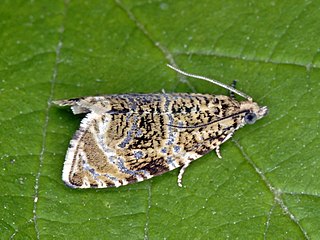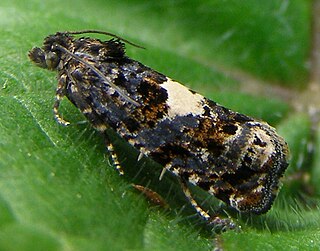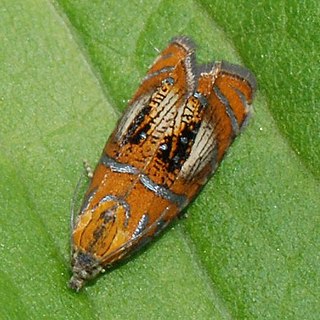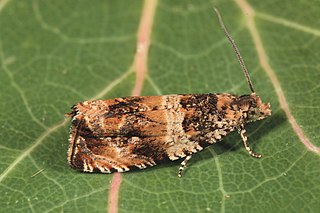
Chlidanotinae is a subfamily of moths in the family Tortricidae.

Celypha cespitana is a moth of the family Tortricidae. It is found in the Palearctic realm, from western Europe to the Ural Mountains, Transcaucasia, Asia Minor, the Near East, Iran, Russia, north-eastern China (Manchuria), Korea and Japan. It is also found in the Nearctic realm.

Syricoris lacunana, the dark strawberry tortrix, is a small moth species of the family Tortricidae. It is found in the Palearctic realm.

Celypha rufana, common name lakes marble, is a small moth species of the family Tortricidae, long known under the junior synonym C. rosaceana.
Inape is a genus of moths belonging to the family Tortricidae.

Celypha aurofasciana is a small moth species of the family Tortricidae. It is native to Europe and the Palearctic but occurs in some other places as an introduced species.

Celypha is a genus of tortrix moths. It belongs to the tribe Olethreutini of subfamily Olethreutinae.

Epiblema is a very large genus of moths belonging to the subfamily Olethreutinae of the family Tortricidae. Most species occur in the Holarctic; a few in South Asia and Africa.

Olethreutes is a large genus of tortrix moths. It is the type genus of its tribe (Olethreutini) and subfamily (Olethreutinae).

Syricoris is a genus of moths belonging to the subfamily Olethreutinae of the family Tortricidae.

The Olethreutini are a tribe of tortrix moths.

Celypha rivulana is a small moth species of the family Tortricidae. It is found in most of Europe.

Celypha flavipalpana is a species of moth of the family Tortricidae. It is found in most of Europe, except Ireland, Great Britain, Fennoscandia, the Iberian Peninsula and most of the Balkan Peninsula.
Celypha atriapex is a moth of the family Tortricidae. It is found in Vietnam.
Celypha sapaecola is a moth of the family Tortricidae. It is found in Vietnam.
Celypha argyrata is a moth of the family Tortricidae. It is found in Vietnam.
Inape celypha is a species of moth of the family Tortricidae. It is endemic to Ecuador.

Celypha rurestrana, the hawkweed marble, is a moth of the family Tortricidae. It was described by Philogène Auguste Joseph Duponchel in 1843. It is found in most of Europe, except Ireland, Lithuania, Ukraine and the western part of the Balkan Peninsula. It is also found in Turkey.

Celypha woodiana also known as the mistletoe marble is a moth of the family Tortricidae found in Europe. In Great Britain the moth is a priority species in the United Kingdom Biodiversity Action Plan. The species was described by Charles Golding Barrett who named it in honour of John Henry Wood.

Celypha capreolana is a moth belonging to the family Tortricidae.














